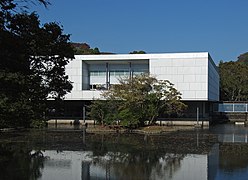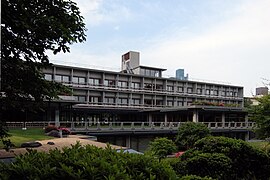Sakakura Junzō
Sakakura Junzō ( Japanese 坂 倉 準 三 ; born May 29, 1901 in Gifu Prefecture ; died September 1, 1969 ) was a Japanese architect of the Shōwa period .
life and work
Sakakura Junzō graduated from the Department of Aesthetics at the University of Tokyo in 1927 and then decided to become an architect. He went to France in 1929 and studied under Le Corbusier on the recommendation of Maekawa Kunio . He returned to Japan in 1936, but did not stay long because he was commissioned to design the Japan Pavilion for the 1937 Paris World Exhibition . The pavilion was awarded the Grand Prix de l'exposition for being seen as a successful example of a combination of modern technology and Japanese aesthetics. During the Pacific War , Sakakura was involved in the adaptation of French prefabricated residential architecture for the construction of army barracks.
After the war, in 1951 he built the " Museum of Modern Art of Kanagawa Prefecture " in Kamakura . It's a good example of modern design despite the shortage of building materials at the time. Other well-known buildings are the Iihashi Villa ( 飯 箸 邸 ), built in 1941 in Todoroki (Tokyo) and urban planning designs such as the western forecourt of Shinjuku station in 1966.
In 1964, Sakakura became president of the Japanese Institute of Architects .
photos
Ashiya Civic Center, 1969
Remarks
- ↑ Together with Maekawa Kunio and Yoshimura Junzō ( 吉 村 順 三 ; 1908–1997).
literature
- Tazawa, Yutaka: Sakakura Junzō . In: Biographical Dictionary of Japanese Art. Kodansha International, 1981. ISBN 0-87011-488-3 .
- Japan Architect (Ed.): Osaka Youth Outdoor Activities Center, 1966. In: A Guide to Japanese Architecture. Shinkenchiku-sha, 1975.
Web links
| personal data | |
|---|---|
| SURNAME | Sakakura, Junzō |
| ALTERNATIVE NAMES | 坂 倉 準 三 (Japanese) |
| BRIEF DESCRIPTION | Japanese architect |
| DATE OF BIRTH | May 29, 1901 |
| PLACE OF BIRTH | Gifu Prefecture |
| DATE OF DEATH | 1st September 1969 |






